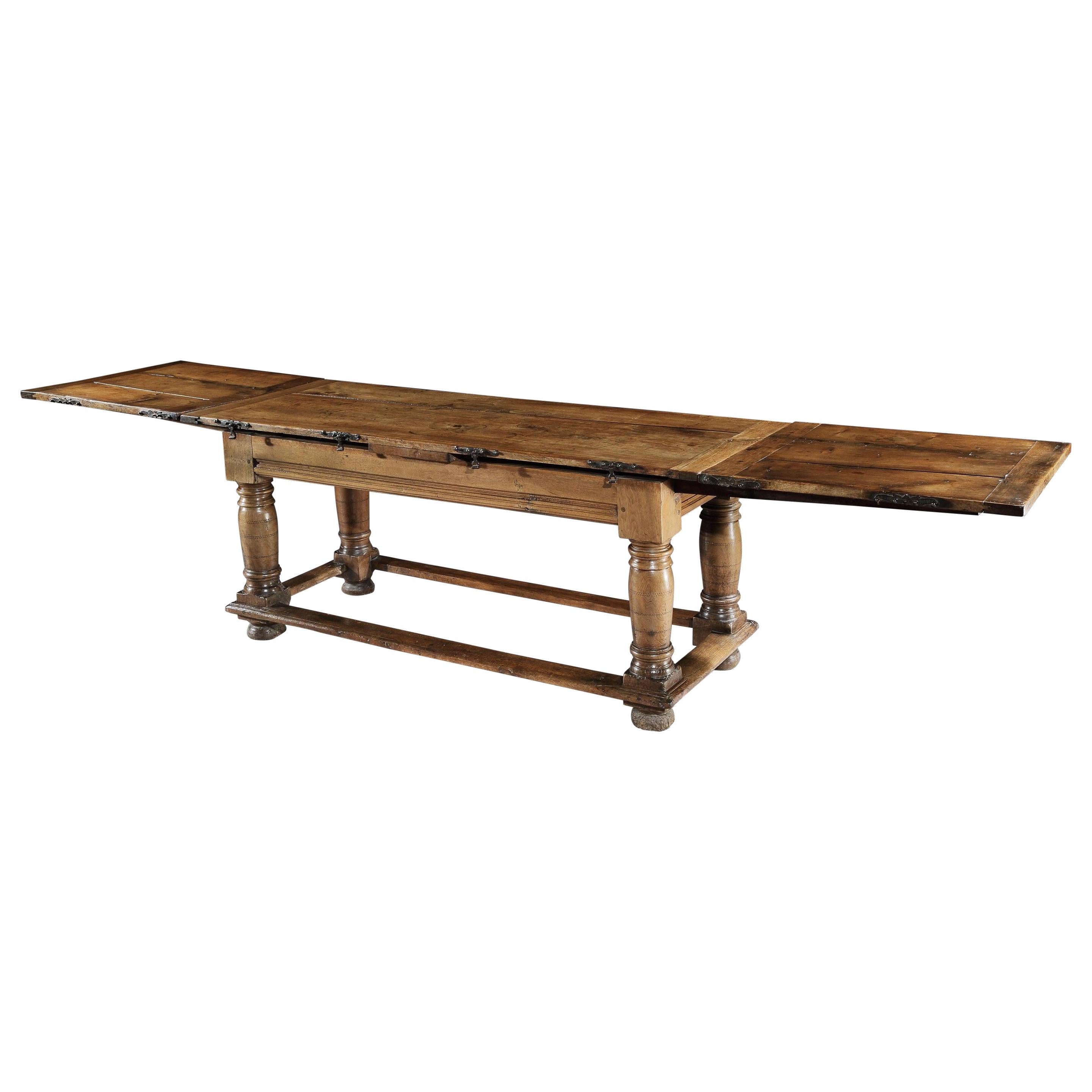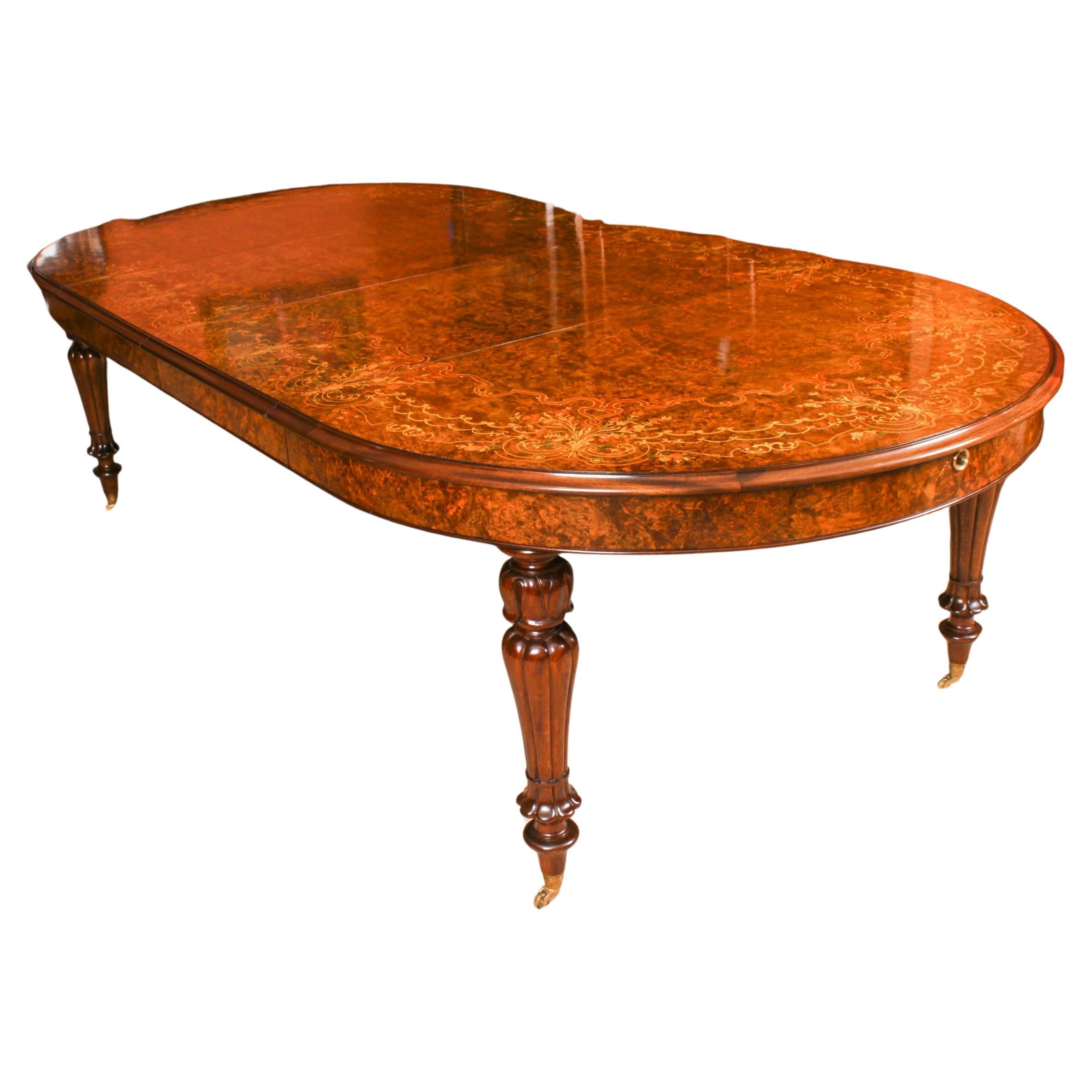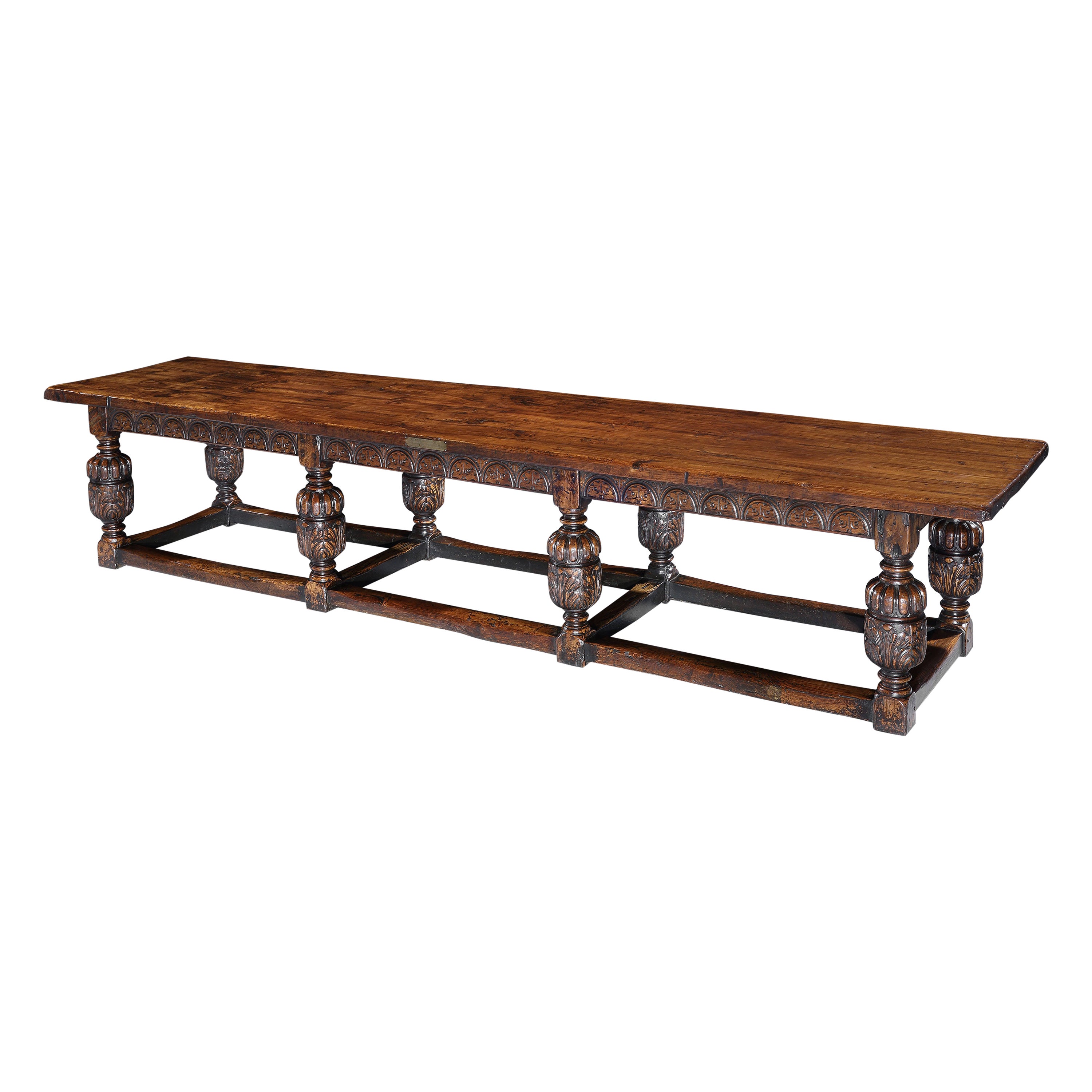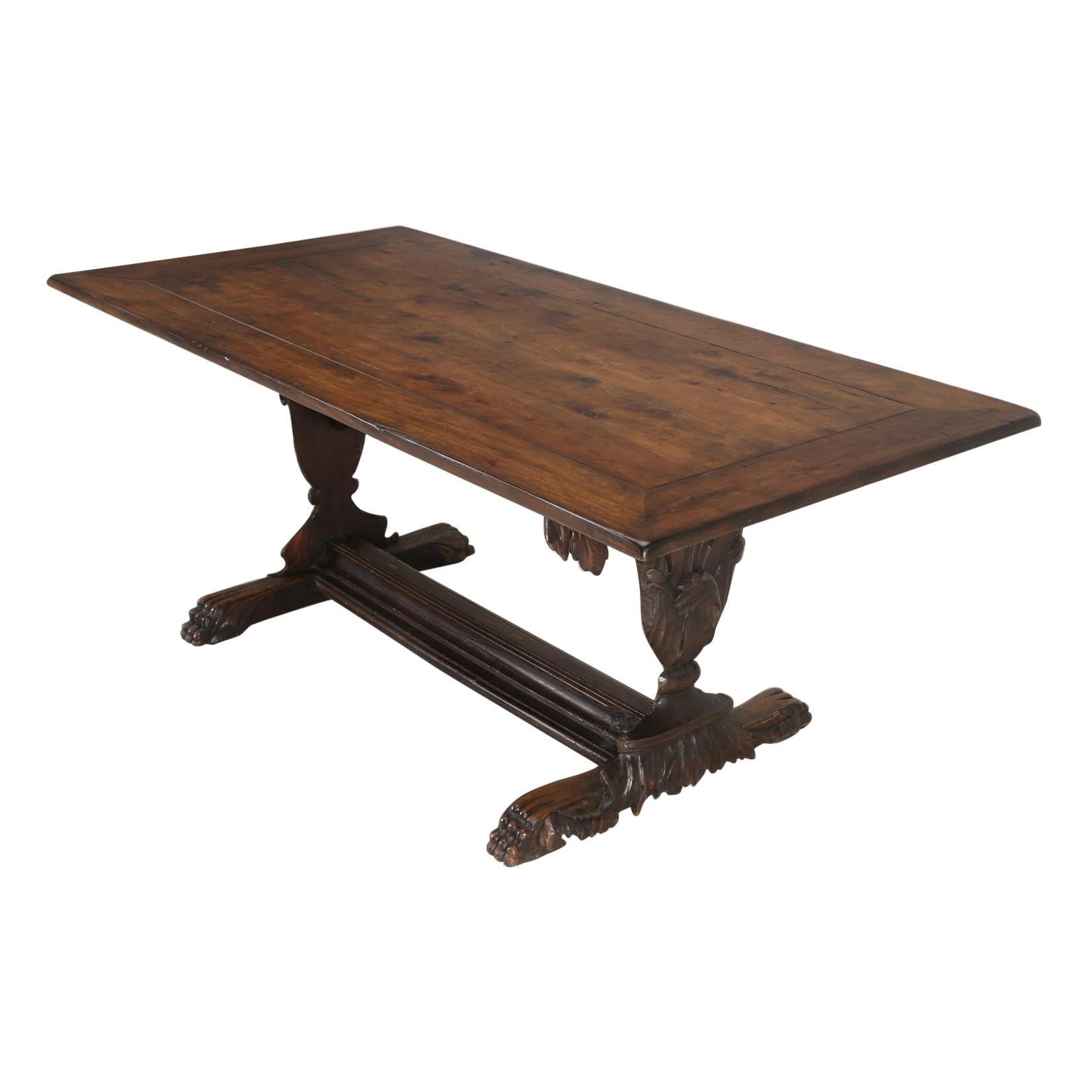Items Similar to Monastery Trestle Table One Plank Walnut Biscione Milan Armorial 14-16 seat 10ft
Want more images or videos?
Request additional images or videos from the seller
1 of 20
Monastery Trestle Table One Plank Walnut Biscione Milan Armorial 14-16 seat 10ft
About the Item
A massive, 14-16 seater, antiquarian, milanese, renaissance-revival, monastery, trestle table with 10ft long, 4 ¼” thick, single plank walnut top & oak trestles carved with an armorial, the heraldic charge of the dukes of milan & heraldic shields.
Monastery tables are long tables with thick, one-piece tops used originally for dining in the Medieval refectory which evolved into banqueting and feasting tables. They are a rare form. I have handled half a dozen over the last 35 years which have all been made from oak and this is the most outstanding and impressive for the following reasons :
- The single plank, 10ft long, 4 ¼” thick walnut top is outstanding oozing character and tacticity. It has old repairs from worm damage and knots falling out. The walnut tree that was felled to make it must have been many hundreds of years old.
- The massive trestles are exceptionally rare, possibly unique. I have never seen and do not know of another table carved with a coat of arms particularly in conjunction with an heraldic charge of the significance of the Biscione. They are crisply carved and made from oak for practicality.
- The trestle form is the most practical and comfortable for seating. Not only is this table 10ft long but it is 34 inches wide which is not common in period tables. The table is the ideal height for a traditional backstool.
- These table are renowned for being ‘as fixed as the freehold’ and the reputed three family ownership provenance of this table supports this.
- Almost certainly made in Italy most likely in Milan, this table is very hard to date and it could be 18th century
- When I acquired the table it was covered in black stain which was very popular in the 19th century. This has been carefully removed revealing the original patina which is a rich, walnut brown with a lustrous surface.
One carved trestle front depicting the Biscione, the heraldic charge of a dragon eating or giving birth to a child which is the symbol of the Visconti family, the Dukes of Milan, who gained control over the city in 1277. The Biscione is a reference to Milan and should be interpreted in conjunction with the coat of arms.
Legend suggests that, around the XIIth century, Tarantasio the dragon arrived in Milan. Many knights tried to free the territory from the unwanted guest, but they all ended up devoured. The news spread with terror among the inhabitants. One day the dragon was about to devour a child, Uberto Visconti defeated the dragon by cutting off its head and saved the child. The Duke thus decided to depict the dragon about to swallow the child on the family crest. The Biscione has become a symbol for Milan found around the city, such as the door of Castello Sforzesco, Milan’s most famous landmark, built in the 14th century by the Duke of Milan.
It is exceptionally rare, possibly unique, to find a coat of arms carved on a trestle table. The Biscione carved on the opposing trestle undoubtedly indicates that the coat of arms is from a Milanese family. Research is underway. The reverse trestle fronts depict a large shield with three bendlets, also being researched
Provenance : Private Collection, Rhineland, acquired 1979 from a Private Collection, Cologne reputedly bought in Italy possibly Milan in the 1920’s from the Palazzo it was made for.
Length 305cm., 120 inches
Width 84cm., 33 inches
Height Overall 82cm., 32”
Height, Underside of top 72cm., 28 /8”
Top thickness 10.5cm., 4¼ inches
Trestle width 33cm., 13 inches
Stretcher thickness 12cm., 4¾ inches
- Dimensions:Height: 32.29 in (82 cm)Width: 120.08 in (305 cm)Depth: 33.08 in (84 cm)
- Style:Renaissance Revival (Of the Period)
- Materials and Techniques:
- Place of Origin:
- Period:
- Date of Manufacture:circa 1800
- Condition:Repaired: old repairs to worm damage and where knots have fallen out. Wear consistent with age and use.
- Seller Location:BUNGAY, GB
- Reference Number:1stDibs: LU3867331818382
About the Seller
5.0
Vetted Seller
These experienced sellers undergo a comprehensive evaluation by our team of in-house experts.
Established in 1985
1stDibs seller since 2018
86 sales on 1stDibs
Typical response time: 10 hours
- ShippingRetrieving quote...Ships From: BUNGAY, United Kingdom
- Return PolicyA return for this item may be initiated within 7 days of delivery.
More From This SellerView All
- Table, Drawleaf, 18-Seat, 16th Century, Italian, Renaissance, Walnut, IronLocated in BUNGAY, SUFFOLKThis massive 18-seat table has many features which are typical of drawleaf tables that were made in the last quarter of the 16th century. Early continental drawleaf tables rarely com...Category
Antique 16th Century Italian Renaissance Dining Room Tables
MaterialsWalnut
- Table Refectory Oak 8 Elizabethan Bulbous Legs Seats20, Gillows Crosby Hall 10ftLocated in BUNGAY, SUFFOLKA massive, 18-20 seater, eight-bulbous legged, antiquarian, elizabethan revival, oak, refectory table, measures: 4.3m/169.30”/14ft long, 89cm/35” wide. Bearing a brass label inscribed 'the gift of lord waring to The British Federation Of University Women, 1st July 1927’. Commemorating Crosby Hall, Cheyne Walk...Category
Antique 19th Century English Elizabethan Dining Room Tables
MaterialsOak
- Table Pine Dining Desk Classical Leg Vernacular FolkLocated in BUNGAY, SUFFOLKPine farmhouse table with a single plank top Rare to find a piece of vernacular or folk furniture with sophisticated features like the leg turnings on this table Length 206cm 81...Category
Antique 19th Century French Folk Art Dining Room Tables
MaterialsPine
- Table, 18th Century, Italian, Baroque, Walnut, Narrow, One Piece TopLocated in BUNGAY, SUFFOLKA rare, narrow, Italian, baroque, walnut, cabinet or sidetable. This table has unusual, narrow proportions and was probably originally conceived as a stand for a table cabinet or ...Category
Antique Early 18th Century Italian Baroque Center Tables
MaterialsWalnut
- Table Centre Dining Library Dismantable X Trestles Oak FruitwoodLocated in BUNGAY, SUFFOLKA South German oak, shaped X' ended table with detachable fruitwood top with decorative cleated band This table is easily dismantled and retains the original pegs The cleated edge ...Category
Antique 17th Century German Baroque Desks and Writing Tables
MaterialsFruitwood, Oak
- Table Refectory Dining Seats18 Antiquarian Parquetry Elm Oak Box 368cm 145" longLocated in BUNGAY, SUFFOLKA MASSIVE, 18 SEATER, LATE-19TH CENTURY, ANTIQUARIAN, REFECTORY TABLE, with an elm top, boxwood and parquetry frieze and oak base 3.68m 145" long - It is virtually impossible to source C17 and earlier dining tables with integrity which are more than 274cm., 108 inches long & period models are narrow around 70cm or 27.50 inches wide - It is very rare to find a table of this size with parquetry decoration which was only used on the finest pieces and is sophisticated elevating its status. - The massive elm top is made from over 10" wide, beautifully figured boards, 1 1/4" thick - The bulbous legs on this table are typical of those found on drawleaf tables that were made in the third quarter of the 16th century. The bulbous or vase-shaped legs were of Flemish and German origin, introduced into England by immigrant craftsmen and through published designs such as those of Dietterlein and De Vries. In early Elizabethan examples, the vase-shape is very pronounced, the bulbs generally being carved with acanthus and gadroons, and terminating at the junction with the frame in Ionic volutes as in this example. - The top is detachable and unusually the base of table can easily be dismantled unlike the 16th century examples whose immovable nature caused them to descend through many generations in the same family, and Evelyn observes in a familiar passage that both in hall and parlour long tables " were as fixed as the freehold " '. Consequently drawleaf tables still survive today in situ some of the great collections, such as Hardwick Hall, while others have passed into the hands of museums such as the Treasurer's House, York - Provenance : Private Collection UK. The Estate Of Wendy Vanderbilt Lehman, USA. Wendy was born in California to Manuela Hudson and Alfred Gwynne Vanderbilt II, a pioneer in thoroughbred racing, who’s father had gone down on the Lusitania. She was great, great granddaughter of Cornelius Vanderbilt, the historic tycoon known as The Commodore. Like many wealthy children of her generation, Wendy grew up largely in the care of nannies, and throughout her childhood she was shuffled between Palm Beach and the Plaza Hotel. Wendy experienced her first sense of belonging at boarding school, where she cultivated life-long loving friendship with her art teacher Betty Klein. She later attended Sarah Lawrence College. In her early 20s Wendy was widely sought after and photographed as a debutant. She was featured in one of Lilly Pulitzer’s first advertising campaigns and attended the Truman...Category
Antique 1880s British Gothic Revival Dining Room Tables
MaterialsBoxwood, Elm, Oak
You May Also Like
- Vintage 10ft Marquetry Burr Walnut Dining Table 20th CenturyLocated in London, GBA fabulous Vintage burr walnut and floral marquetry 10ft dining table, dating from the late 20th Century. It is made from burr walnut which has a b...Category
Late 20th Century Dining Room Tables
MaterialsWalnut
- 17th Century Painted Italian Trestle Table with Walnut TopLocated in Wichita, KSFabulous 17th century Italian trestle dining table with and 18th century walnut top. The legs have original finish. The top is thick walnu...Category
Antique 17th Century Italian Baroque Dining Room Tables
MaterialsWalnut, Wood
- Antique French Hand Carved Solid Walnut Trestle Dining Table Restored in HouseLocated in Chicago, ILAn 18th century Hand Carved Solid Walnut French Trestle Table. This Country Walnut French Dining Table offers breathtaking beauty with its incredible urn-form pedestals overflowing w...Category
Antique 1790s French Country Dining Room Tables
MaterialsWalnut
- French Oak Harvest Trestle TableLocated in Staffordshire, GBFrench oak harvest trestle table, circa 1900. X-framed pine trestle with a replacement oak top made from 300 year old oak beams. A good vers...Category
Antique Early 1900s French Dining Room Tables
MaterialsOak, Pine
- French Antique Monastery Trestle TableLocated in Austin, TXTrestle table from France handcrafted in Solid oak with a unique trestle pedestal and double stretcher. This piece has peg construction and is finished with a Carnauba wax finish. Th...Category
Antique Early 1900s French Dining Room Tables
MaterialsOak
- Sunset Dining Table, 8 ft, in Dark Walnut by August AbodeLocated in Los Angeles, CAIntroducing our artisan-made Sunset Dining Table. A new piece with a timeworn feel--the solid wood top is paired with lathe-turned legs, which taper down to ball feet. The design melds vintage-inspired details with a contemporary scale. Inspired by candle-lit dinners perched atop Lookout Mountain...Category
21st Century and Contemporary American Dining Room Tables
MaterialsOak, Walnut
Recently Viewed
View AllMore Ways To Browse
Oak Plank Table
Antique Oak Planks
Monastery Furniture
Table One Plank
Antique Plank Dining Table
Oak Trestle
Old Plank Tables
16 Seat Table
16 Seater Table
Antique Trestle Dining
Trestles Used
Plank Door
Antique Trestle Dining Table
Antique Dragon Table
Italian Trestle
Used Cutting Table
Plank Italy
Trestle Table Used





